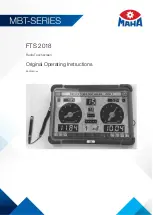
5.5
Using the DuraTech Mini SRL-P
Before each use, inspect the DuraTech MIni in accordance with Section 7. Remove the device from service if the inspection shows
damage or any malfunction.
Don the FBH and/or attach the SRL in accordance with the harness manufacturer’s instructions.
Follow the instructions contained in this manual and on the labels. Failure to follow instructions may result in serious injury or death.
Connect the leg-end connector to an approved anchorage point or to the full body harness depending on orientation. Ensure the
connector closes and locks. In a Twin-leg configuration attach the unused leg end connector to the FBH’s lanyard keeper. Ensure all
connections are compatible. Normal operation will allow the working length of the lifeline to extend and retract as the worker
moves about. When using a Twin-leg configuration, it is possible to move laterally between anchor points with 100%
tie-off as shown in Figure 6.
Figure 6 -
Twin-Leg SRLs for Lateral Movement
102022
MSRD07 Rev F
9
5.4
Attaching to an Anchorage
Examine the work area for possible hazards. Take caution to avoid overhead hazards such as cranes, poles, overhead power cables, and
walking/working surface hazards such as power cables, welding leads, air and fluid hoses, including obstruction hazards such as vertical
columns and stacks of materials on the lower level. Eliminate hazards where possible.
Ensure the anchorage provides the Minimum Required Fall Clearance (MRFC) in the fall path below the walking/working surface to
prevent striking the lower level or an obstruction during a fall event. Take action to avoid swing falls, which occur when the anchorage is
not directly above the point where the fall occurs.
Fall clearance and swing falls are subject to variable conditions. Anchor height, lateral movement, and setback distance all affect anchor
location with regard to fall clearance and swing falls.
The SRL may be attached to an overhead anchor, i.e., above the user’s FBH dorsal D-ring, or a non-overhead anchor, i.e., below the user’s
FBH dorsal D-ring. A non-overhead anchor may be a maximum of 5’ (1.5 m) below the user’s FBH dorsal D-ring. Non-overhead anchor
locations result in greater possibility of edge hazards. At no point during a fall shall the lifeline be loaded over any edge. Use of a below
D-ring anchorages should be as a last resort, when no other anchor option exists. When anchored below the FBH back
D-ring, fall events will result in greater fall clearances.
A
C
B
D
E
DO NOT
Attach directly to the Dorsal D-ring
INCORRECT
INCORRECT
INCORRECT
INCORRECT
CORRECT
DO NOT
Attach to intersecting web straps over/above the Dorsal D-ring
DO NOT
Attach to only one of the intersecting web straps
DO NOT
Attach anywhere outside the intersecting web straps
CORRECT
attachment to both intersecting web straps with
Dorsal D-ring in the up position
Figure 7B:
Incorrect Twin-leg SRL Attachment



































